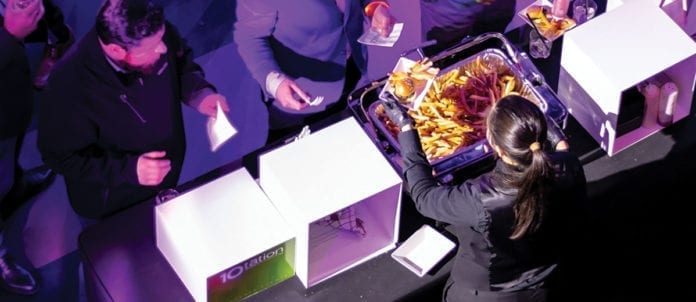Anyone with experience in catering off-site events will tell you things can get unpredictable. Limited power supplies, tight spaces, power outages and inclement weather can all play a role in how caterers manage the job at hand.
While the choices of equipment are plentiful — from live chef-station accoutrements to full-size ovens and refrigerators — there are a few basic qualities that always matter: durability, reliability, flexibility and mobility. Because, if anything fails, an entire off-site event can quickly go off the rails.
THE BASICS
Judy Reeves, owner of Edge Catering in Vancouver, says equipment selection relies on a wide range of factors — from the menu selections, to the amenities at the venue, to regulatory requirements. For example, given the strict rules around propane storage, transport and usage, she always sources items such as barbecues or propane-powered stoves from rental suppliers. “We organize deliveries from them so they can bring them directly to the site.”
In fact, most caterers rent a large majority of their cooking and food-preparation equipment. “When working with large and complex events, you rely on rental partners. They can put together a package for you that’s appropriate. Even if we had space to inventory equipment, storing it is not something we want to do,” Reeves says.
Needless to say, the variety in the style of events/functions is endless — as is the equipment required. Caterers can be asked to manage everything from fork-friendly, stand-up events with small tastings to live chef station self-service venues to full-blown sit-down dinners.
Reeves says she’s seeing a growing interest in more casual interactive experiences, which increases the need for items such as carving stations, induction cooktops, heat lamps, butane burners and smaller convection ovens.
BEYOND THE EQUIPMENT
While menu is the number-1 deciding factor, another is logistics at the venue itself, she adds. “A lot of them have power issues, because you often need designated circuits for some equipment.”
She typically prefers butane, where possible, over electric to avoid having to worry about plugs and cords. “Butane burners can control heat better. However, induction also has its benefits for sauces and larger-volume items — if it can be easily plugged in.”
David D’Aprile, owner of 10tation Event Catering in Toronto, notes some venues are very specific about the type of equipment you’re allowed to use. “At the Canadian Opera Company or Royal Conservatory, for example, you can’t use propane. In those cases, we use a lot of induction burners. The only problem is you can only plug one into a circuit. These are the types of things you learn as you go.”
Warming cabinets are an absolute must for groups of more than 100 people, Reeves notes. “Keeping food at a safe temperature and keeping it fresh is integral.” Her preferred vendor is California-based Cambro.
Another critical part of catering an event in the great outdoors is a generator or two, Reeves says. “We usually rent diesel generators that we share with the tents for the heating, lighting and DJs.”
A must-have item that can be overlooked is a hand-washing station. D’Aprile says he likes to use three-compartment sink units when working off-site.
THE COLD FACTOR
One of the biggest challenges for off-site catering is refrigeration, Reeves says. “Make sure any venue you consider has refrigeration, particularly when you’re working with more-vulnerable items such as seafood. Where refrigeration is limited, ensure that staff is available to serve food immediately.”
One of D’Aprile’s most-important equipment investments is refrigerated trucks for transporting food. “I can’t stress the importance of refrigeration enough. You would be surprised at how many venues don’t have it.”
ONSITE TO OFFSITE
At The Food Dudes in Toronto, executive chef of Development Brandon Bannon says much of the preliminary food-prep work is done in its kitchen. The cooking is then finalized on location.
Popular items on his offsite checklist are the usual induction and butane cooktops. Another essential piece is a Rational combi-oven. “It makes catering life a lot easier because you can do multiple types of cooking on one piece of equipment, from roasting steak and steaming buns to dehydrating.”
The Food Dudes also has a 15-foot natural-gas offset smoker from Texas on site. “We do a lot of smoking for barbecue events,” he says. “The smoker is stationary, so we can get all the smoke flavour done here and then finish it on a rented barbecue or oven off site.”
When barbecuing, he usually opts for a gas model, but will use wood or charcoal grills if he has staff with the right skill levels to work with them.
GRILLING FOR THE MASSES
Dennis Jeffery chef/owner of Fork+Farm Catered Events in Calgary is one caterer that has opted to purchase as much of his own equipment as he can.
“I hate renting. I like to work with what’s familiar. I know my heat sources and what I’m doing. There are so many variables involved in catering and so many opportunities for things to go wrong. Having the pieces I want in inventory gives me some control.”
One of Jeffery’s centrepiece items is a proprietary propane-powered $7,000 PigOut Roaster. The six-foot long rotisserie-and-grill system is ideal for pig roasts and other large cuts of meat. It also has attachments that allow Jeffery to add stainless-steel baskets for roasting corn and chickens. The entire unit is on a pneumatic system so it can be rolled off a truck and wheeled into place by one person.
He uses his roaster for major barbecue events such as the Calgary Stampede, where he serves upwards of 2,000 customers a day. Jeffery also brings along a four-foot-long Traeger smoker, as well as “lots of portable ovens, deep fryers and hotboxes.”
For indoor occasions, he often uses induction, particularly in venues where the facility doesn’t allow flames indoors. But his favourite piece is a full-sized Garland convection oven that he’s modified with off-road wheels. “That’s a game changer for catering — you can produce restaurant-level food in the middle of a field. I love it.
Written by Denise Deveau


















